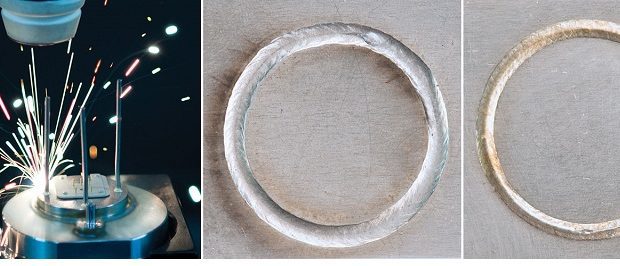No More Depression at the End of a Laser Weld
SmartRamp technology from Prima Power Laserdyne provides consistent endpoint control during laser welding, eliminating areas where potential weld failure can occur to produce uniform weld penetration along the entire length of the weld.
Posted: April 18, 2018
SmartRamp™ technology from Prima Power Laserdyne, LLC (Champlin, MN) provides consistent endpoint control during laser welding, eliminating areas where potential weld failure can occur. It is one of many proprietary features of the S94P control used to operate the Laserdyne 795 and Laserdyne 430BD multi-axis laser systems. SmartRamp produces uniform weld penetration along the entire length of the weld. With standard laser welding practice, the laser power is often ramped down at the end of the weld after the start point has been overlapped. Despite the most careful control of ramping, this method leaves a noticeable depression at the end point. In many applications this depression is undesirable. In hermetic welds, for example, a depression at the end point can be a leak point. Hermetically-sealed electronic packages are widely used in the electronics, communications, automotive, computer, and medical industries. The quality and durability of the hermetic seal in these packages must be high as failure of the seal can lead to corrosion of the package contents and premature failure of the device.
A depression at the end point is also undesirable in welding applications in the aerospace industry. This defect can act as potential stress riser, leading to reduced fatigue and creep strength of the welded component during its service. Conventional laser welding techniques for controlling the overlap, when used, will often require extensive testing to insure that the conditions described above are not present. By comparison, SmartRamp controls laser parameters in conjunction with motion of the beam, eliminating the occurrence of a visible endpoint of the weld. To validate the effectiveness of this control, extensive metallographic analysis were carried out on welds produced using SmartRamp. These consistently showed the absence of porosity or any other welding defects at the end of the weld. By comparison, metallographic tests carried out on standard welding samples confirmed that the end point can be the site of some porosity and inconsistent weld penetration.
SmartRamp has been developed to be easily incorporated into a laser welding program to give product designers confidence that new designs using the process are more robust with significantly less chance of failure. It is a standard feature within the S94P control used on Laserdyne 3-axis to 7-axis systems, including the Laserdyne 795, Laserdyne 430BD, and Laserdyne 606D laser systems.
Prima Power Laserdyne, LLC, 8600 109th Avenue North, #400, Champlin, MN 55316, 763-433-3700, Fax: 763-433-3701, www.primapowerlaserdyne.com.















